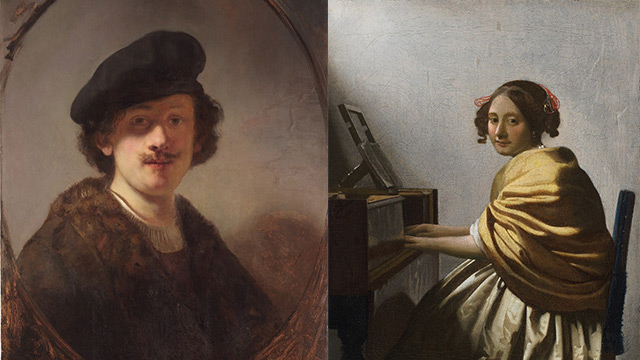CulBeat Express
2019.02.28 18:12
루브르 아부다비 뮤지엄 렘브란트-베르메르와 네덜란드 거장전(2/14-5/18)
조회 수 899 댓글 0
루브르뮤지엄 아부다비가 렘브란트 사망 350주년을 맞아 '렘브란트, 베르메르와 네덜란드 황금기 거장전'을 연다.
Landmark Exhibition of Works by Rembrandt, Vermeer and Other Masters of the Dutch Golden Age Opens at Louvre Abu Dhabi on 14 February
Largest Showing to Date in the Gulf Region of Works by Dutch 17th-Century Masters Marks 350th Anniversary of Rembrandt’s Death

Louvre Abu Dhabi will present Rembrandt, Vermeer and the Dutch Golden Age: Masterpieces from The Leiden Collection and the Musée du Louvre, from 14 February through 18 May 2019. It constitutes the largest exhibition of Dutch Masters from the 17th century held in the Gulf region to date. This extraordinary assemblage of 95 paintings, drawings, and objects—including more than 20 works from across Rembrandt van Rijn’s career and by his workshop—surveys Rembrandt’s artistic journey in 17th-century Leiden and Amsterdam, as well as his relationships with rivals and peers including Jan Lievens, Ferdinand Bol, Carel Fabritius, Gerrit Dou, Frans van Mieris, Frans Hals and Johannes Vermeer.
Among the many highlights in the exhibition are two works by Vermeer—The Lacemaker (Musée du Louvre) and Young Woman Seated at a Virginal (The Leiden Collection)— that were painted on canvas cut from the same bolt. In the exhibition, these have been hung side by side for what is thought to be the first time in 300 years. Also of special note are: the first display at Louvre Abu Dhabi of the museum’s most recent acquisition, Rembrandt’s oil sketch Head of a Young Man, with Clasped Hands: Study of the Figure of Christ, ca. 1648-56; and the first-ever combined display of Rembrandt’s Bust of a Bearded Old Man (The Leiden Collection) with the special carrying case commissioned for it by a previous owner of the painting, Andrew W. Mellon, the eminent early 20th-century financier and philanthropist.
The exhibition is organized by Louvre Abu Dhabi, The Leiden Collection, the Musée du Louvre and Agence France-Muséums.
The Dutch Golden Age was a brief period during the 17th century when the Dutch Republic, newly independent from the Spanish Crown, established itself as a world leader in trade, science, and the arts, and was regarded as the most prosperous state in Europe. Worldwide trade, driven by the Dutch East India Company and Dutch West India Company, gave the Netherlands (the coastal region of northwest Europe) an important advantage throughout Europe and the world. Rembrandt and Vermeer established themselves at the forefront of a new artistic movement characterized by a deep interest in humanity and daily life.
In this context, the exhibition explores the evolution of Rembrandt’s career starting in his native Leiden where he created his early famed series of allegorical paintings of the Senses. These works demonstrate the artist’s youthful ingenuity and experimentation with expression, composition and colour. Paintings created later in Amsterdam are also on display, including sensitively rendered portraits, the renowned Self-Portrait with Shaded Eyes, and Minerva in Her Study, his monumental history painting of the goddess (both from The Leiden Collection). These works are displayed alongside paintings by other masters from Rembrandt’s artistic circle, illustrating the influence that this remarkable group of artists had on each other’s work.
The exhibition is drawn primarily from The Leiden Collection, one of the largest and most significant private collections of artworks from the Dutch Golden Age, interspersed with masterpieces from the Musée du Louvre’s exceptional Dutch collection. Loans from the Rijksmuseum and the Bibliothèque Nationale de France complete the presentation.
Highlights from The Leiden Collection include: Johannes Vermeer’s Young Woman Seated at a Virginal (ca. 1670-72); Rembrandt’s Self-Portrait with Shaded Eyes (1634); Gerrit Dou’s Scholar Interrupted at His Writing (ca. 1635); Jan Lievens’ Boy in a Cape and Turban (Portrait of Prince Rupert of the Palatinate) (ca. 1631); and Rembrandt’s Young Lion Resting (ca. 1638-42).
Among the highlights from the Musée du Louvre’s collections are: Johannes Vermeer’s The Lacemaker (1669-70); Gerrit Dou’s Self-Portrait with Palette in a Niche (ca. 1660-65); Ferdinand Bol’s Rebecca and Eliezer at the Well (ca. 1645-46), a gift from the family of Thomas S. Kaplan and Daphne Recanati Kaplan in 2017; and an engraved nautilus shell (ca. 1660-80).
The exhibition also features a very rare and beautifully crafted 17th-century ship model from the Rijksmuseum. It is the first time such an object has traveled to the United Arab Emirates.






